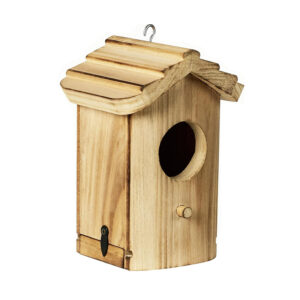Nestled amidst the branches of a tree or perched atop a wooden post, a bird house is more than just a functional shelter for our feathered friends—it’s a charming addition to any garden or backyard, inviting nature to flourish in our midst. Join us on a journey as we explore the enchantment of bird houses, from their intricate designs to their vital role in supporting avian life.
Craftsmanship and Design: Bird houses come in a delightful array of shapes, sizes, and designs, each crafted with care and attention to detail. From traditional wooden cottages to whimsical replicas of famous landmarks, there’s a bird house to suit every taste and style.
Wood is a popular choice of material for bird houses, offering a natural look and feel that blends seamlessly with outdoor environments. Cedar and pine are commonly used due to their durability and resistance to rot, ensuring that your bird house will stand the test of time.
For those seeking a more decorative touch, bird houses can be adorned with intricate carvings, colorful paintwork, or charming details like miniature windows and doors. Some even feature intricate scrollwork or stained glass accents, adding a touch of elegance to any garden or backyard.
Functionality and Placement: While aesthetics are important, the primary function of a bird house is to provide a safe and comfortable nesting space for birds. When choosing a bird house, it’s essential to consider the needs of the species you wish to attract. Different birds have different preferences when it comes to nesting habitats, so it’s important to do your research and select a bird house that meets their specific requirements.
Placement is also crucial when it comes to attracting birds to your garden. Bird houses should be mounted on sturdy poles or hung from tree branches at a height of at least five to ten feet above the ground, away from potential predators like cats and squirrels. They should also be positioned in a quiet, sheltered spot with easy access to food and water.
Benefits to Bird house and Wildlife:
Bird houses play a vital role in supporting avian life, providing much-needed shelter and protection during the nesting season. By providing a safe and comfortable habitat for birds to raise their young, bird houses help to increase breeding success rates and support healthy populations of local bird species.
There’s something truly magical about watching birds flit and flutter around our gardens, their melodious songs adding a soundtrack to our outdoor adventures. Providing a haven for these winged wonders is not just a delightful hobby—it’s a meaningful way to connect with nature and support local biodiversity. Join us as we explore the captivating world of bird houses, from their diverse designs to the joy they bring to both birds and humans alike.
The Art of Design: Bird houses are more than just functional structures—they’re miniature works of art that add charm and character to any outdoor space. Crafted from a variety of materials including wood, metal, and even recycled materials like old tin cans or wine corks, bird houses come in an endless array of shapes and sizes.
Traditional wooden bird houses, with their rustic charm and natural appeal, are a perennial favorite among bird enthusiasts. They can be simple and rustic or intricately designed with decorative details like shingles, windows, and doors. Cedar and pine are popular choices due to their durability and resistance to rot, ensuring that your bird house will withstand the test of time.
For those with a flair for creativity, DIY bird houses offer endless possibilities for customization. From repurposing old teapots and watering cans to crafting elaborate fairy-tale castles, the only limit is your imagination. Not only does building your own bird house allow you to tailor it to the specific needs of local bird species, but it also adds a personal touch to your garden.
Functionality and Placement: While aesthetics are important, the primary purpose of a house is to provide a safe and comfortable nesting space for birds. When choosing or designing a bird house, it’s essential to consider the needs of the species you wish to attract. Different birds have different preferences when it comes to nesting habitats, so it’s important to do your research and select a house that meets their specific requirements.
Placement is also key when it comes to attracting birds to your garden. Bird houses should be mounted on sturdy poles or hung from tree branches at a height of at least five to ten feet above the ground, away from potential predators like cats and squirrels. They should also be positioned in a quiet, sheltered spot with easy access to food and water.
The Benefits of Bird Houses: play a vital role in supporting avian life, providing much-needed shelter and protection during the nesting season. By providing a safe and comfortable habitat for birds to raise their young, houses help to increase breeding success rates and support healthy populations of local bird species.
In addition to providing shelter, houses can also help to attract a variety of beneficial insects to your garden, including pollinators like bees and butterflies. This creates a thriving ecosystem that benefits both wildlife and gardeners alike, promoting biodiversity and enhancing the beauty of outdoor spaces.
Conclusion: Whether you’re a seasoned bird enthusiast or simply looking to add a touch of charm to your garden, a well-placed house is sure to bring joy and wonder to your outdoor space. By providing a safe haven for birds to nest and raise their young, houses allow us to play a meaningful role in supporting local biodiversity and connecting with the natural world around us. So why not embark on your own house adventure and create a sanctuary for the feathered friends in your neighborhood?

